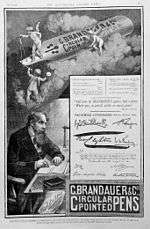Birmingham pen trade
The Birmingham pen trade evolved in the Birmingham Jewellery Quarter and its surrounding area in the 19th century; for many years, the city was the centre of the world's pen trade.[1]
History
19th century
.jpg)

In Newhall Street, John Mitchell manufactured pens; he pioneered mass production of steel pens (prior to this, the quill pen was the most common form of writing instrument). Mitchells are credited as being the first manufacturers to use machines to cut pen nibs, greatly speeding up the process. John's brother William later set up his own pen-making business in St Paul's square.[2]
Baker and Finnemore operated in James Street, near St Paul's Square; C. Brandauer & Co Ltd. (founded as Ash & Petit) traded at 70 Navigation Street; Joseph Gillott & Sons Ltd. made pen nibs in Bread Street (now Cornwall Street) for companies such as Perry & Co.; Hinks, Wells & Co. traded in Buckingham Street; George W. Hughes traded in St Paul's Square; Leonardt & Catwinkle (then D. Leonardt & Co.) traded in George and Charlotte Streets, and M. Myers & Son. were based at 8 Newhall Street.
In 1828 Josiah Mason improved a cheap, efficient slip-in nib which could be added to a fountain pen. This was based on existing models.
By the 1850s, Birmingham existed as a world centre for steel pen and steel nib manufacture; more than half the steel-nib pens manufactured in the world were made in Birmingham. Thousands of skilled craftsmen and -women were employed in the industry. Many new manufacturing techniques were perfected in Birmingham, enabling the city's factories to mass-produce their pens cheaply and efficiently. These were sold worldwide to many who previously could not afford to write, thus encouraging the development of education and literacy.
20th century
Richard Esterbrook manufactured quill pens in Cornwall. During the 19th century, Esterbrook saw a gap in the American market for steel-nib pens. He approached five craftsmen who worked for John Mitchell in Navigation Street, with a view to setting up business in Camden, New Jersey, USA. Esterbrook later went on to become one of the largest steel-pen manufacturers in the world. He returned to Birmingham for help when in 1928 the British Government placed restrictions on US imports. John Mitchell's factory was used to produce Esterbrook pens within the UK (Mitchells were then operating in Moland Street). In 1930 Esterbrook introduced a fountain pen in Britain which had a nib made of osmiridium, which eventually replaced large-scale production of steel-tipped pens.
During World War II, pen manufacture in the city was somewhat disturbed. Mitchell's factory on Moland Street was struck by an incendiary bomb; the premises were partially rebuilt during the war with government aid, on condition that a government stationery office and ammunition assay office could reside there. Esterbrook were still manufacturing pens in Birmingham until 1973.
During the first half of the 20th century Swan Pens opened a large gold pen-making factory in the city, taking advantage of the skilled gold workers of the jewellery quarter, and at the same time Osmiroid International had a large production plant in the city.
See also
- D. Leonardt & Co.
- Perry & Co.
- Joseph Gillott's
- Calligraphy
- Dip pen
- Birmingham Pen Trade Heritage Association
- List of pen types, brands and companies
References
- ↑ Pen Museum & Learning Centre Accessed January 27, 2011.
- ↑ Samuel Timmins (1967). Birmingham and the Midland hardware district. Routledge. ISBN 0-7146-1147-6.
